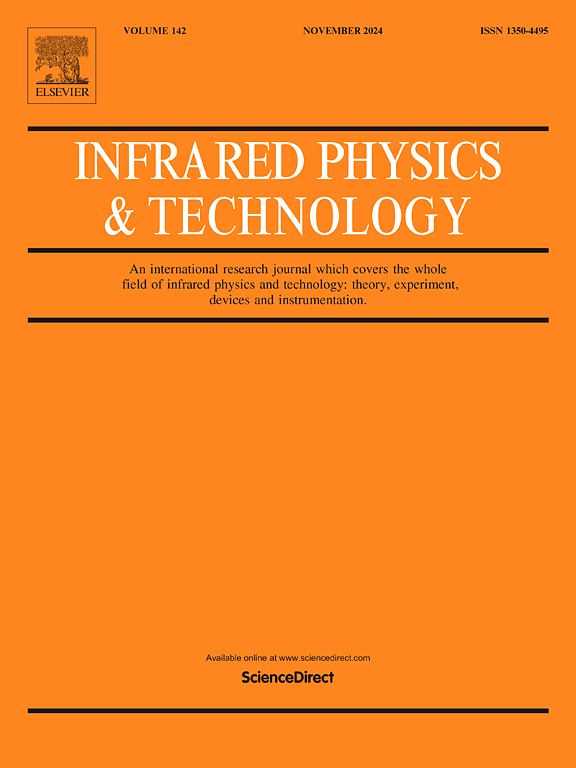All-fiber mid-infrared supercontinuum generation with high coherence in chalcogenide fiber pumped by 2.8 µm Raman femtosecond solitons
IF 3.1
3区 物理与天体物理
Q2 INSTRUMENTS & INSTRUMENTATION
引用次数: 0
Abstract
We present an all-fiber mid-infrared supercontinuum (MIR-SC) generation in As2S3 chalcogenide glass fiber, powered by a 2.8 µm femtosecond laser generated through the soliton self-frequency shift (SSFS) effect in fluoride fiber. To ensure high-quality femtosecond laser pulse production, we thoroughly investigated the SSFS effect in three types of fibers using 2.0 µm femtosecond laser as pump source. Ultimately, we obtained 2.8 µm soliton pulses with an average power of 241 mW, a conversion efficiency of 42.5 % and a peak power reaching 36.5 kW in an 8 m-long ZrF4-BaF2-LaF3-AlF3-NaF (ZBLAN) fiber. By injecting the 2.8 µm pulses into a segment of As2S3 fiber, where this wavelength situated rightly in the normal dispersion region of this fiber, a SC spanning from 1.83 to 4.0 µm was generated with excellent spectral flatness. Furthermore, we simulated the spectral evolution of the pulses in the As2S3 fiber, the simulation results showing strong agreement with experimental observations. The spectral coherence factor was estimated close to 1 across the entire spectral range, indicating a good coherence of this SC.
以2.8µm拉曼飞秒孤子泵浦的硫系光纤中产生高相干的全光纤中红外超连续谱
我们提出了在As2S3硫系玻璃光纤中产生全光纤中红外超连续体(MIR-SC),由氟光纤中孤子自频移(SSFS)效应产生的2.8µm飞秒激光供电。为了保证高质量的飞秒激光脉冲产生,我们使用2.0µm飞秒激光作为泵浦源,深入研究了三种类型光纤中的SSFS效应。最终,我们在8 m长的ZrF4-BaF2-LaF3-AlF3-NaF (ZBLAN)光纤中获得了平均功率为241 mW、转换效率为42.5%、峰值功率为36.5 kW的2.8µm孤子脉冲。通过将2.8µm脉冲注入As2S3光纤的一段,该波长正好位于光纤的正常色散区,产生的SC跨度为1.83 ~ 4.0µm,具有良好的光谱平整度。此外,我们还模拟了脉冲在As2S3光纤中的光谱演变,模拟结果与实验观测结果吻合较好。光谱相干系数|g12(1)|在整个光谱范围内接近于1,表明该SC具有良好的相干性。
本文章由计算机程序翻译,如有差异,请以英文原文为准。
求助全文
约1分钟内获得全文
求助全文
来源期刊
CiteScore
5.70
自引率
12.10%
发文量
400
审稿时长
67 days
期刊介绍:
The Journal covers the entire field of infrared physics and technology: theory, experiment, application, devices and instrumentation. Infrared'' is defined as covering the near, mid and far infrared (terahertz) regions from 0.75um (750nm) to 1mm (300GHz.) Submissions in the 300GHz to 100GHz region may be accepted at the editors discretion if their content is relevant to shorter wavelengths. Submissions must be primarily concerned with and directly relevant to this spectral region.
Its core topics can be summarized as the generation, propagation and detection, of infrared radiation; the associated optics, materials and devices; and its use in all fields of science, industry, engineering and medicine.
Infrared techniques occur in many different fields, notably spectroscopy and interferometry; material characterization and processing; atmospheric physics, astronomy and space research. Scientific aspects include lasers, quantum optics, quantum electronics, image processing and semiconductor physics. Some important applications are medical diagnostics and treatment, industrial inspection and environmental monitoring.

 求助内容:
求助内容: 应助结果提醒方式:
应助结果提醒方式:


